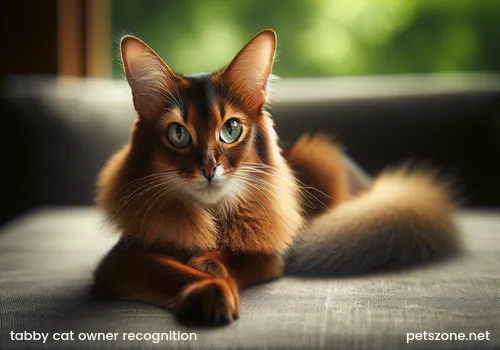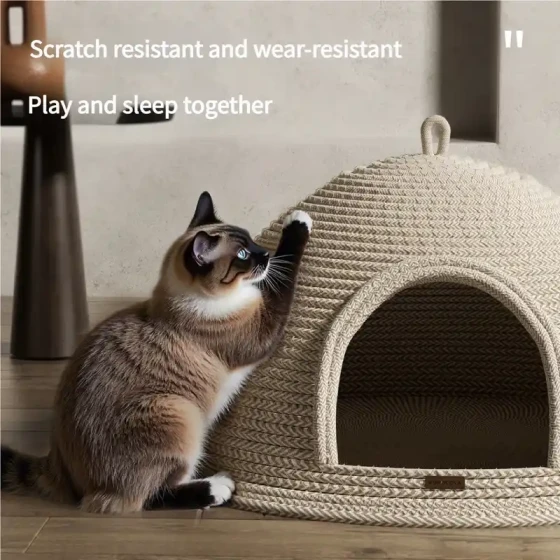At what age does a tabby cat recognize its owner_The golden period of recognition revealed
Many new cat owners are quite concerned about at what age a tabby cat recognizes its owner. After all, who wouldn’t want their master to be "officially recognized" early, so they can enjoy a "one person, one cat, peaceful life"? But this issue really isn’t something that can be summarized by just a simple number like "three months" or "half a year." It involves animal behavior science, breed characteristics, and even a bit of mysticism (just kidding).
First, we need to clarify that the term "recognizing the owner" in the cat world is not exactly the same as the dog’s "loyalty and protection of the master." Cats, especially our native tabby cats, inherently carry some wild traits and are independent little hunters. Expecting it to greet you like a golden retriever, running to you with a full 360-degree Thomas spin upon returning home, might be a bit unfair to cats. A cat’s "recognition of the owner" is more about knowing you, trusting you, considering you a stable source of food, a safe harbor, and… uh, a competent "can opener" and "cat teaser holder." It will rub against you to leave its scent, respond to your calls (although sometimes with a cool, indifferent attitude), and relax by sleeping and purring near you. That counts as its approval of you.
So, is there really a so-called "golden period" in this recognition process?

Key window of cat socialization
The answer is yes, but more accurately, it’s the key window of cat socialization (Socialization Period). This period is crucial for all cats, including our big tabby.
It is generally believed that the core socialization period of cats is approximately from 2 weeks to 7 weeks after birth (some say up to 9 weeks). During this phase, kittens are like sponges, absorbing information about the world wildly: recognizing the mother and siblings, learning rules of cat-to-cat interaction, encountering humans and other (friendly) animals, and becoming familiar with various sounds, smells, and objects in the environment.
- Early exposure sets the tone: Cats that have positive and gentle human interaction during this window period usually grow up to be more affectionate, confident, and better adapted to family life. Conversely, if this period is missed or includes negative experiences (such as rough handling), kittens may become timid, fearful of people, or even aggressive. Correcting this later? Not impossible, but the difficulty level and time required grow exponentially.
Think about it — just like in human infants, parental companionship and positive interaction are crucial to character development. Animal behavior science has long concluded that early experiences profoundly influence an animal’s lifelong behavior patterns. Dr. Konrad Lorenz from Austria, who raised a bunch of geese, studied the "imprinting effect," which, although focusing on birds, revealed the powerful force of early learning.
Tabby cat’s “owner recognition” pace
Alright, here’s the key point. Since 2-7 weeks is the foundational golden period, does that mean a tabby cat will "recognize" its owner at 7 weeks old?
No, no.
This socialization window period establishes the broad framework of "trusting humans." Specifically "recognizing" you as its particular "owner" takes more time.
- From familiarity to dependence (approximately 3-6 months): Generally, when kittens are brought to a new home, they have usually passed the core socialization period (it is generally recommended to leave the mother and littermates at 2-3 months old). At this time, they need time to adapt to the new environment and new "roommate" (that’s you). During this stage, if you can provide stable food, clean water, a safe and comfortable resting place, and maintain patient and gentle interaction (for example, playing with toys they like and speaking softly to them), then in about 3 to 6 months you will clearly notice changes in their attitude toward you.
- They begin to approach you actively instead of always hiding in corners.
- When you come home, they might run to the door and "meow" (although it might just be reminding you it’s feeding time).
- They allow you to pet them for longer periods and may even actively rub their head or body against you.
- They adopt more "unguarded" sleeping positions near you, such as exposing their belly (the ultimate trust signal among felines).
This 3-6 months stage can be regarded as the critical development period for the tabby cat to establish a deep bond and gradually "recognize" a particular human owner, or an extension and deepening of the "golden period." The kitten’s personality gradually stabilizes, and it begins to understand that this biped is reliable, providing food, shelter, and companionship.
- Personality traits of tabbies: We must consider the breed characteristics of tabby cats. They are intelligent and curious but relatively independent. They may not cling to you all the time like some other cat breeds, but that doesn’t mean they don’t recognize you. A tabby’s love might be more introverted, emphasizing an "allies on equal footing" kind of respect. It may prefer silently observing you or "supervising" you from a short distance while you work. This sense of distance reflects their independent personality. Don’t forget, tabby cats are a breed that has undergone thousands of years of natural selection and semi-wild filtering in human living areas. Without some "survival wisdom" and "independent spirit," they wouldn’t last. They are more like roommates sharing a rental; when the relationship is good, you can be like brothers, but expecting them to become your constant "shadow" depends on fate and your "personal charm."
How to seize (or create) this golden period?
Whether you take a kitten home when it is 2 months old or adopt a few-months-old or even an adult tabby, the key to having it "recognize" you lies in your daily efforts.
- Provide a stable and reliable life: This is the foundation of the foundation. Feed on time, keep the litter box clean, and provide safe hiding and resting spots. Let it know your home is a "safe harbor unshaken by storms."
- Patience and respect are key: Cats aren’t dogs. Forcing cuddles or hugs only backfires. Especially for a cat as personality-filled as the tabby, give it space and choice. Don’t bother it when it wants to be alone; interact gently when it approaches. Use food and toys as bridges to build affection. Remember, more haste less speed.
- High-quality companionship: Dedicate fixed time daily to play with it using a teaser wand or laser pointer (be careful not to shine it into its eyes directly, and let it catch a tangible "prey" at the end). This not only consumes energy and satisfies its instincts but greatly enhances your bond. Energetic tabbies need interactive games.
- Learn cat language: Observe its body language and sounds. Fly-back ears, puffed fur, tail flicks (unlike dogs, cats flick their tails quickly usually to signal annoyance or tension), purring, various "meows"… Understanding its emotions allows you to react appropriately.
- Start petting from the head: Most cats like being petted on the top of the head, chin, and sides of the cheeks. These areas have their glands; rubbing you there is their way of marking "ownership" (see, reverse owner recognition, isn’t it?). After it trusts you enough, try petting its back. The belly? That’s the highest trust zone—don’t touch unless it actively flips over asking for belly rubs.
Is there still a chance for adult tabby cats?
Of course! Although missing the kitten socialization window and key development period means adult cats (especially those that experienced being stray or psychological trauma) need much more time and patience to build trust, it’s definitely not impossible. Many cases show that even seemingly "wild" adult tabbies can gradually open their hearts and form deep emotional bonds with humans in a loving and secure environment. It might take months or even longer, but the sense of accomplishment when you finally gain their trust is something those who have been through it truly understand.
In summary, the tabby cat’s "recognition of the owner" is not an event precise down to the day but a continuous developmental process. 2-7 weeks is the foundation socialization, and 3-6 months is the key period to establish a deep connection with a specific owner, but this door never completely closes. Whether or when a tabby "recognizes" you largely depends on your behavior, patience, and the quality of your interaction.
Instead of obsessing over "at what age it recognizes the owner," focus on how to become a biped worth its trust and dependence. When you truly respect its nature, meet its needs, and provide continuous care and security, you will find that it has long since, in its unique way, included you within its "territory."
After all, making a tabby with inherent royal temperament "bow its head" has never relied on force but on your continuous output of love and respect, right?




